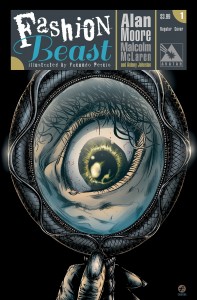
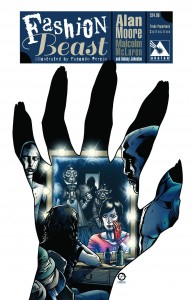
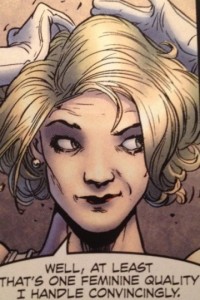
The artwork on FASHION BEAST is strong, but not overstated. Avatar is known for its host of variant collector covers, but in this instance, the covers for the series are fascinating, providing strange windows into meaning and significance. Some depict heightened scenes from the story, while some are more fashion-oriented and seem to make claims about the characters and roles they play. Particularly desirable are the more expensive Tarot card covers by Paul Duffield, a blend of traditional Tarot images and ethereal clear-line artwork. A cover gallery collection might be in order for a book like this because they are so evocative of the story. One of the most appealing features of the series, beyond the fact that it stems from the mind of such an eminent storyteller, are the colors. Their simplicity, and consistency are selling features, and the palette is duly sepulchral, near-Gothic, with excellent contrast in purples, golds, and reds that may actually be an intentional nod to traditional Tarot colors. The colors leave room for the inking, always deeply-lined with an eye toward texture. So much of the story can only fly within a convincingly created visual world, and colorist Hernan Cabrera deserves a great deal of credit for its success, alongside artist Facundo Percio who has an uncanny ability to freeze moments of movement and emotion focused on gesture and facial expression.
When fans refer to the elements of a screenplay still visible in the comic, they are probably noting the use of wide-screen panels to establish settings, particularly early on in the comic, and also the use of panning in frame by frame in panel structure, too. In the first issue, when we are introduced to Doll and Jonni’s rooming house, we get the sense of a large cast, initially, the way a film might establish a social group based on their domestic lives. There are also plenty of silent panels that focus on reactions or the sequences of a task being performed which suggest a camera’s view of events. In the first issue, the silent panels occasionally number as many as 5 per page, and the entire first issue has an unhurried pace, setting the mood and tone for the rest of the series, though it also ends in tension, like the rest of the issues. But I wouldn’t agree with any claims that this is simply a screenplay loosely cut into acceptable comic format; it shows consistent use of comic storytelling techniques, even if it fits the “decompressed” format most common in long story arcs these days.
For those wondering if they ought to pick up FASHION BEAST, whether in back issues or in collected format, keep in mind that this is an urban fairy-tale with some gritty commentary on human nature, that it handles themes of sexuality on a page-by-page basis, and that it has strong, if flawed, protagonists who are successful at maintaining your interest in their fates. It is a very entertaining book with humorous dialogue and plenty of noble, pathetic, and petty behavior to remind you that it’s a comic about humanity, and what that means. It is not, however, an action story that’s comprised of post-apocalyptic combats or superheroic bravado. You’ll get angry, violent mob scenes, and the context of war, but the tension in the story revolves around the paths the characters choose to follow and how honest they are with themselves and others.
[*Spoilers start here!]


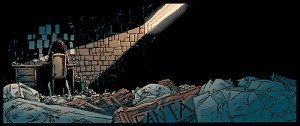
As Doll begins to eclipse Jonni in her confidence in issues #4 and 5, often forced and sieve-like, you have to wonder if she’s taking out her past feelings of abuse on him. Now she’s top of the heap and has somebody else to kick around. When she was the underdog she was fairly heroic, but she’s not turning out to be a good master. This adds to the seriousness of FASHION BEAST as a story about humanity. She can’t be gracious to others because she’s never lived in a gracious world, never been given a break in life, until now, and doesn’t know how to grow into her new state. She becomes a little two dimensional during the mid-sections of the story-line, and we wonder if she deserves to be moved around like a mannequin if that’s all she really wants to be in life. As we learn in issue #5, she’ll even take credit for Jonni’s ideas to ingratiate herself to Celestine. This leads to one of the funniest and strangest full-page spreads in the series when Doll and Jonni grapple like a pair of pre-schoolers in a spilled vat of psychedelic paint. It hammers home that they are being depicted as child-like once inside Celestine’s walls, a kind of regression and reforming of their identities and under Celestine’s rule, that’s how they will probably stay, with no room for growth in the carefully moderated atmosphere of repression. Another shocking moment in issue #5 is when Celestine, confronted in the dark by Jonni, beats Jonni savagely like an abused son, but only after Jonni calls him out on what he considers to be extreme failure of vision. Their relationship is revealed to be the definition of unhealthy, and the reader is reminded that Celestine is a “beast”, not a tame creature.
Yet Celestine’s declaration in issue #6 that “in the image, there is power!” rings true for the world of the book. It explains where he has come from and how he has achieved his status, forcing an image on the world to command respect and invite obedience. It explains Doll’s initial dressing up and Jonni’s clothing choices. Clothing has become a way that people control their own sense of reality in FASHION BEAST. What may occur to the reader later, however, is that the image in control, whatever it may be, can therefore be changed, and the power can be shifted. That’s virtually heretical under the rule of Celestine, but it’s one that gets Jonni beaten up. Doll moves further into Celestine’s dark world as she spends more time with him and realizes the enslavement his mother created for him, particularly the use of the sinister mirror to keep him totally devoid of personal ego. The reveal that Celestine is, in fact, handsome, may be one that readers see coming in the Beauty and the Beast tradition, depending on what versions of the fairy-tale you’ve read or seen. But it is still poignant, contrasting with his mother’s extremely abusive legacy. Doll’s agreement not to tell him the “truth” about his appearance is extremely dubious. She’s safeguarding her position, refusing to rock the boat, and that’s suspect. Like his mother, she feels she’s doing him a favor by keeping him down. That shows how much Doll has become a mannequin, really, devoid of emotion by training. She’s not ready to make personal decisions about change for herself or for Celestine.
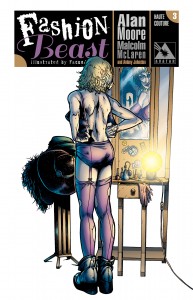
When reading the single issues, I wondered how FASHION BEAST could make two more issues worthwhile after Celestine’s gory suicide. And I may have even been a little put off by this fairy-tale. There was enough ambiguity in Celestine’s death at the end of issue #8 that it could have been a lesson in Doll’s failure to reach him, as a person, in her Doll-like state. I wondered how she could come back from that kind of failure. But the fact that before dying, Celestine asks Doll to return to her roots in a vague way, through music, raised questions. Was he encouraging Doll not to lose her humanity? And yet she turns around and keeps Jonni from his inheritance in the protection of the status quo, a status quo that outlives through inertia, even Celestine’s wishes. It’s a major testament to way that Celestine has transformed her. She had become a product, an object, the example of the “power” in the “image”, which for Doll, had everything to do with the clothes she wore. The juxtaposition of Doll with a sketch of Celestine’s mother at the end of issue #9 suggests that she has become Celestine’s mother, something the fashion guru was not-so-subtly creating in her all along. There’s a real possibility, too, that the new reign of an old terror could have continued in that vein without direct interruption from a resistant force in the form of Jonni.
Jonni’s return is abrupt, maybe even perfunctory, and the final issue of the series does come off as a little rushed, but by withholding detail, the comic leaves room for ambiguity, one which no doubt Moore intended to stick with readers. He returns as a conquering force, with the authority of Celestine (is this really what he wanted to be?) and speaks to doubts in Doll’s mind about the whole trajectory of events. She seems a little easily led in this conversion to Jonni’s vision, but we could assume that her own resistance has been reaching boiling point and waiting for an opportunity to explode. By agreeing to wear Jonni’s clothes, even a wedding dress, she’s showing an attraction to her old life and way of thinking, some of her old bravado, at least. Her violent showdown with the matrons is also some of the old Doll coming out, fighting for her life, and some scrap of identity, though in doing so she becomes the “image” of the new age. How believable is it that she and Jonni wind up as “the Lovers” of the Tarot?

FASHION BEAST leaves you with the unsettling sense that people, even the most free-thinking can be the product of reaction, and in doing so, like Jonni, become part of what they loathe. Or, in a lighter interpretation, compromises are inherent in power attained, a corruption hidden in power, part of the Faustian bargain. Some of the biggest questions left for the reader concern how much people are self-determining in their identities, and how much a product they are of their heroes or mentors, taking the good with the bad. The Doll of issue #1 had some sterling qualities, and we aren’t sure if they fully emerge again by the end of the series. Jonni, too, had some points for bravery and vision throughout the series, but some of that may have been lost in his overconfidence by the end. Together they might make up the sum of the parts necessary to forge a different path than Celestine’s, but they aren’t out of danger. And whether they ever will be is left to the reader. The series does tell a complete story, however, one with definite movements and with specific ideas in play, and that makes it significant and ambitious. It would have been a great shame for the screenplay never to have seen a visual format for fans, and though it might have made a strong film, it makes a solid comic series, perhaps an even more solid graphic novel, for readers to revisit with new questions.
Title: FASHION BEAST, #1-10/ Publisher: Avatar Press/ Creative Team: Alan Moore, Malcolm McLaren, Antony Johnston, writers, Facundo Percio, artwork, Paul Duffield, Tarot covers, Facundo Percio, covers, Hernan Cabrera, colors, Jaymes Reed, letters
Hannah Means-Shannon writes and blogs about comics for TRIP CITY and Sequart.org and is currently working on books about Neil Gaiman and Alan Moore for Sequart. She is @hannahmenzies on Twitter and hannahmenziesblog on WordPress. Find her bio here.


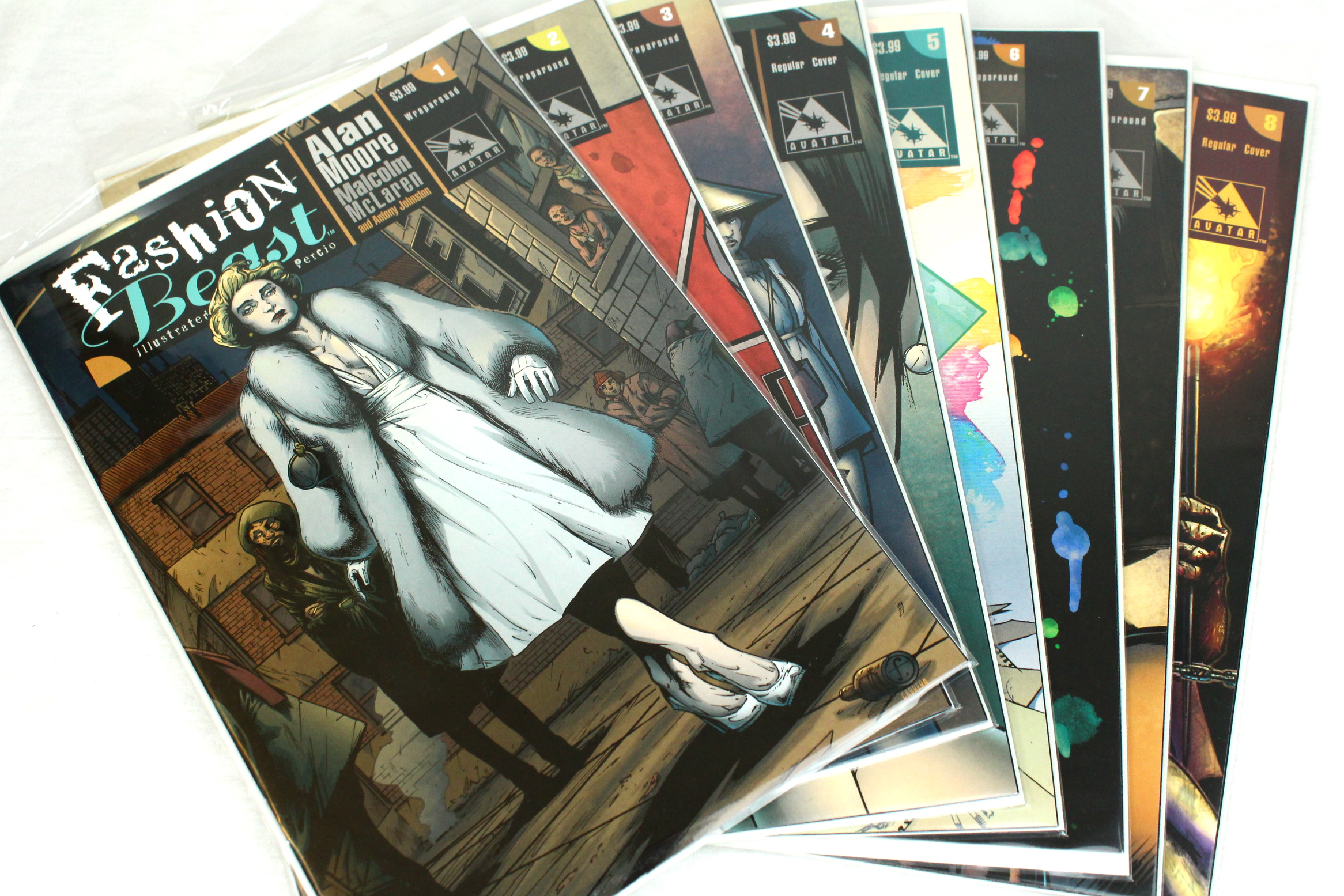
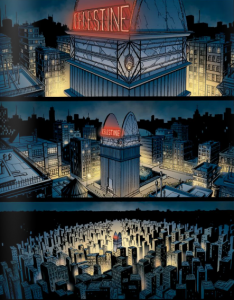
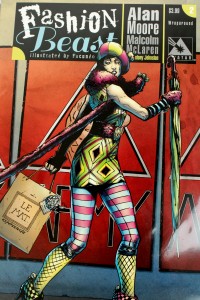
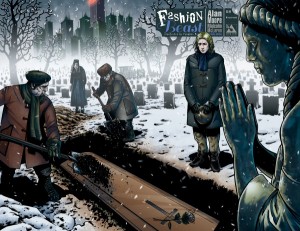

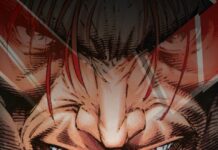
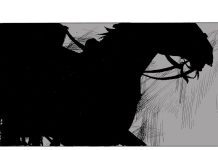







Yeah, it was a great series. I love what it made me think about.
Nice write-up, too. You did this great story justice!
I like the contrast between Celestine’s dress for Doll – a black funeral dress – and Jonni’s dress – a white wedding dress. One’s vision is of death and ending, while the other is of life and creating something new. It was one of the nicer touches to this interesting tale.
First Alan Moore title I did not like. I stuck with it until about #7 and just couldn’t keep going. Maybe I need to re-read it after seeing some of these reviews b/c with people like Moore or Morrison one read is sometimes not enough to grasp it all. Maybe I don’t get it yet, but as of right now, I did not like Fashion Beast. More power to ya if you did.
Your review really did open my eyes to appreciate the series a bit more. I didn’t love it, but it has been certainly growing on me since i’ve read it
Comments are closed.